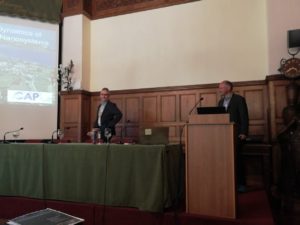Joint Psi-K / CECAM workshop: Ultrafast Physics from Molecules to Nanostructures
Dates: 7-10. October 2019
Location: San Sebastian, Spain
The impressive progress in ultrafast laser technology, ranging from the femtosecond to the attosecond timescale and from the THz to the XUV frequency range, is making possible to probe real-time electronic and nuclear dynamics in atoms, molecules and solids. Fundamental insight can be gained into the primary photoinduced processes in systems with growing level of complexity. The capability of following and steering ultrafast dynamics has tremendous impact in a wide range of applications, from materials science to life sciences.
Clearly, advances in theories and methods inevitably require an intense exchange with the experimental community due to the complexity of the systems and of the measurements. In the last decade the effort in developing predictive and computationally feasible methods has virtually exploded. Ab initio approaches based DFT and nonequilibrium Green’s function (NEGF) have recently made contact with time-resolved experiments in 2D systems and nanostructures. Other ab initio methods based on wavefunctions (e.g., ADCn, CASPTn) or reduced quantities (e.g., TDDFT, NEGF) are opening up high prospects to access the electron-nuclear subfemtosecond dynamics in molecules. Furthermore, accurate real-time numerical methods have been put forward for strongly correlated model systems (e.g., TD- DMFT and DMRG).
The workshop has gathered world-leading experimental, theoretical and computational experts working in the field of electronic and nuclear dynamics in atoms, molecules and solids. These four days have provided a unique cross- fertilization opportunity to advance the current ab-initio state-of-the-art approaches. Several key and crucial questions have been vividly and intensely debated: how to extend the accuracy of ab-initio methods out-of-equilibrium? How to efficiently benefit from the advances in computation facilities to simulate the nonequilibrium dynamics of large molecules, nanostructures and solids? How to translate laser-pulse features (pulse center frequency, bandwidth, duration, fluence, polarization) into boundary conditions and suitable approximations for the computational tools? Can we devise a series of tools and procedures to provide to the community? We have also confronted different theoretical formulations of experimental outcomes, discuss their range of applicability as well as their physical and numerical limitations. For the various approaches we have explored how to include the missing physics and whether this inclusion is numerically feasible.
Organisers:
Giulio Cerullo (PM, Milano)
Hardy Gross (MPI, Halle)
Andrea Marini (CNR, Rome)
Mauro Nisoli (PM, Milano)
Angel Rubio (MPI, Hamburg)
Gianluca Stefanucci (UTV, Rome)

